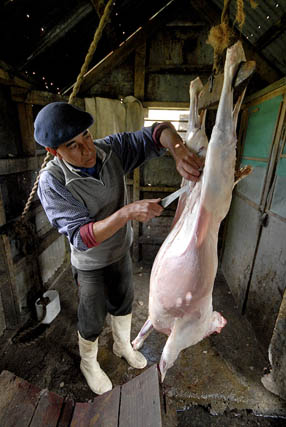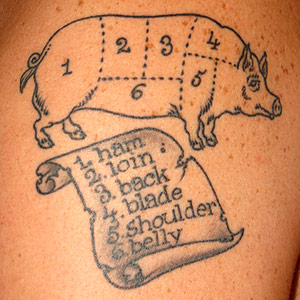Robert Cribb of the Toronto Star is reporting tonight that two Ontarians were hospitalized — and another two deaths are being investigated — in relation to a listeria outbreak traced to a Toronto deli meat manufacturer.
 Its part of a dramatic spike in listeria cases in Ontario since January that has renewed concerns about the country’s food safety system 18 months after 22 Canadians died in the Maple Leaf tragedy (fiasco – dp).
Its part of a dramatic spike in listeria cases in Ontario since January that has renewed concerns about the country’s food safety system 18 months after 22 Canadians died in the Maple Leaf tragedy (fiasco – dp).
Packages of prosciutto cotto cooked ham and mild cacciatore salami made by Siena Foods Ltd. have been targeted as a possible cause in the outbreak.
The company’s salami was recalled in December and the ham was recalled early Friday. Both were sold to delis, grocery stores, specialty food stores and supermarkets after January 11.
“We are using a variety of different methods to … prevent any further exposure to this product by the public,” said
Siena officials did not respond to interview requests Friday.
Since January, the province has had 14 confirmed listeria cases (six in Toronto) — well beyond the eight that is typically expected for this point in the year, said Dr. Arlene King, Ontario’s chief medical officer of health.
Two Torontonians were sickened by a strain of the pathogen that matches with the Siena meat, hospitalized and are now recovering, she said. At least seven people across the province have been hospitalized since January from listeria.
Two Ontarians died during the same time the tainted Siena meat was in the marketplace, she confirmed. But provincial officials are still investigating whether there is a direct connection between those deaths and the company’s products.
Rick Holley, a microbiologist and food safety expert at the University of Manitoba and a consultant with the Canadian Food Inspection Agency (CFIA) said,
“I haven’t seen improvement. We haven’t seen any reduction, in my view, of the risk. We’re not doing foodborne illness surveillance the way we should. I’m not encouraged that, materially, we’ve got the kind of buy-in by industry we need to move forward with confidence.”
 Doug Powell, a Canadian food safety expert at Kansas State University, said,
Doug Powell, a Canadian food safety expert at Kansas State University, said,
“There’s clearly some bad stuff going at that plant. I would like (health officials) to be clear about what they know, what they don’t know and what they’re doing about it. I don’t know how these Canadian health types are allowed to operate the way they do and not say anything.”
Timeline:
December 21, 2009: The CFIA recalls Siera salami
March 3: The ministry began a detailed investigation with local health units to identify source of the illness
March 5: The ministry released an “enhanced surveillance directive” to health units to identify any other cases
March 9: The ministry was notified of the test results of food samples taken from one of the two cases of hospitalized victims. The genetic fingerprint from the prosciutto was an exact match to the salami and a sample taken from one of the infected people.
March 11: The CFIA recalls Siera cooked ham

 The salami is sold by Siena Foods based in Toronto and was voluntarily recalled by the manufacturer on Dec. 21, 2009, the Canadian Food Inspection Agency said Wednesday. The best before date on the packaged meat is May 4, 2010.
The salami is sold by Siena Foods based in Toronto and was voluntarily recalled by the manufacturer on Dec. 21, 2009, the Canadian Food Inspection Agency said Wednesday. The best before date on the packaged meat is May 4, 2010. Apparently, Tijssen’s house had been under surveillance for several days last November before officers from the Ministry of Natural Resources and Ottawa police stopped a car leaving the property and confiscated 18 kilograms of pork. Tijssen and a friend had jointly bought a pig and slaughtered it.
Apparently, Tijssen’s house had been under surveillance for several days last November before officers from the Ministry of Natural Resources and Ottawa police stopped a car leaving the property and confiscated 18 kilograms of pork. Tijssen and a friend had jointly bought a pig and slaughtered it. Brent Ross, a spokesman for the Ontario Ministry of Agriculture, Food and Rural Affairs, said the ministry moderates its enforcement of meat handling rules for religious or ethnic reasons, for example, when Muslims slaughter animals for religious reasons.
Brent Ross, a spokesman for the Ontario Ministry of Agriculture, Food and Rural Affairs, said the ministry moderates its enforcement of meat handling rules for religious or ethnic reasons, for example, when Muslims slaughter animals for religious reasons..jpg) Two weeks ago, London Free Press reporter Jonathan Sher
Two weeks ago, London Free Press reporter Jonathan Sher 
 Jonathan Sher of the London Free Press
Jonathan Sher of the London Free Press.jpg) “We’ve gone six months now with the star ratings. What we’ve seen is much positive comment from owners and consumers,” Bennett said.
“We’ve gone six months now with the star ratings. What we’ve seen is much positive comment from owners and consumers,” Bennett said..jpg) But this would be especially tragic – or hopelessly sad — if proven.
But this would be especially tragic – or hopelessly sad — if proven..jpg)
.jpg) Specifically, Romahn said,
Specifically, Romahn said, Carrie Pich of Windsor, Ontario
Carrie Pich of Windsor, Ontario.jpg) Both products are among those listed in the recall.
Both products are among those listed in the recall.